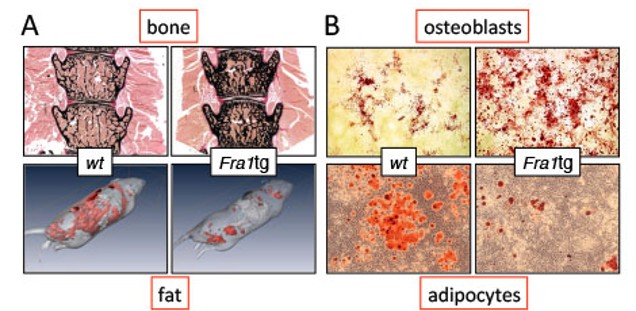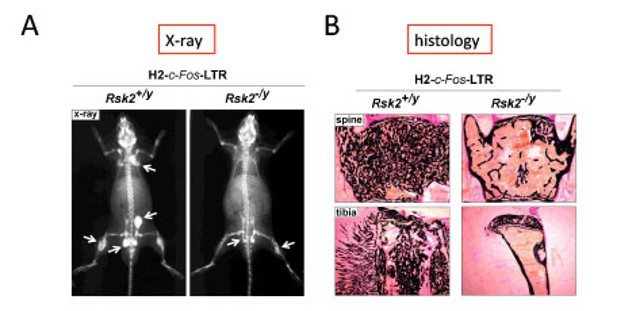Transcription and Gene expression
Head:
Jean-Pierre David
Ph.D. Students:
Stefan Teufel
Chistina Baldauf
Obesity leading to cardiovascular failure as well as diabetes and aging-associated osteoporosis are two of the main health problems in developed countries.
Five observations established the intimate connection of bone and adipose tissues.
1- The bone forming cells (osteoblasts) and the adipose cells (adipocytes) originate from a common progenitor called mesenchymal stem cell (MSC).
2- Aging is associated to a parallel increased fat mass and decreased bone mass.
3- Fat accumulation and bone remodeling are co-regulated by neuropeptides controlling appetite and energy expenditure.
4- Cytokines produced by adipose tissues (adipokines) regulate bone remodeling.
5- A hormone produced by the bone forming cells regulates fat accumulation.
Thus, adipose tissue and bone directly and indirectly regulate each other.
Our working hypothesis:
MSCs should be instructed to properly integrate the local and systemic messages in order to differentiate into adipocytes or osteoblasts. Therefore, perturbation of this integrative signaling should cause bone and/or adipose pathologies.
What are we doing?
We are trying to identify new integrators of bone and adipose tissue formation in order to understand the molecular mechanisms leading to the development of bone and metabolic diseases.
Our model:
Genetically modified mice that develop bone tumor (osteosarcomas), aging-mediated bone loss (osteopenia and osteoporosis), increased bone formation (osteosclerosis), fat loss (lipodystrophy), increased fat mass (obesity).
Our approach:
Our research is centered on the function of a family of transcription factors called AP-1 that we and others have shown genetically to co-regulate fat and bone metabolism in mice (Figure1).
Thus, based upon the specific bone pathologies induced by over-expression of specific Fos members of AP-1 we are addressing:
1- The participation of the 3 Jun dimerization partner of Fos in the development of Fos-dependent bone pathologies.
2- The role of the post-transcriptional modification of Fos and Jun in the development of bone pathologies (Figure 2).
3- The differences between the patterns of genes regulated by the different AP-1 members.
4- The development of adipose phenotypes in the AP-1 mutated mice.
Our goal is to identify genes and pathways that could be targeted for the treatment of bone and metabolic pathologies in human.
Students are welcome and interested persons should contact j.david@uke.de
Recent publications:
Böhm C, Derer A, Axmann R. Hillienhoff U, Zaiss MM, Luther J, Zech C, Stock M, Scholtysek C, Engelke K, Hess A, Tuckermann JP, Schett G. and David JP. RSK2 protects mice against TNF-induced bone loss. J Cell Sci. 125:2160-2171, 2012.
Luther J, Driessler F, Megges M, Hess A, Herbort B, Mandic V, Zaiss MM, Reichardt A, Zech C, Tuckermann JP, Calkhoven CF, Wagner EF, Schett G and David JP. Elevated Fra-1 expression causes severe lipodystrophy. J Cell Sci. 124:1465-1476, 2011
Zaiss MM, Frey B, Hess A, Zwerina J, Luther J, Nimmerjahn F, Engelke K, Kollias G, Hünig T, Schett G and David JP. Regulatory T cells protect from local and systemic bone destruction in arthritis. J. Immunology. 184:7238-7246, 2010.
Zaiss MM, Sarter K, Hess A, Engelke K, Böhm C, Nimmerjahn F, Voll R, Schett G and David JP. Increased bone density and resistance to ovariectomy-induced bone loss in Foxp3-transgenic mice based on impaired osteoclast differentiation. Arthritis Rheum. 62:2328-2338, 2010.
Schett G and David JP. The multiple faces of autoimmune-mediated bone loss. Nat Rev Endocrinol. 6:698-706, 2010.
Schett G and David JP. Osteoimmunology. Rheumatology, 5th edition. Elsevier, 2010.
David JP and Schett G. TNF and Bone. Curr Dir Autoimmun. 11:135-144, 2010.
Böhm C, Hayer S, Killian A, Zaiss MM, Finger S, Hess A, Engelke K, Kollias G, Krönke G, Zwerina J, Schett G and David JP. The alpha-isoform of p38 MAPK specifically regulates arthritic bone loss. J Immunol. 183:5938-5947, 2009
David JP. Osteoimmunology: a view from the bone. Advance in Immunology, 95: 149-165, 2007.

